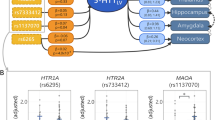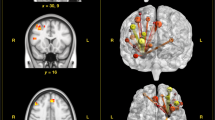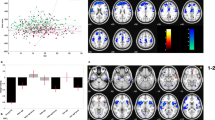Abstract
The serotonin transporter-linked polymorphic region 5-HTTLPR is a key genetic regulator of 5-HTT expression in the human brain where the short allele S has been implicated in emotion dysregulation. However, the neural mechanism underlying the association between this variant and emotion processing is still unclear. Earlier studies suggested an effect of 5-HTTLPR on amygdala activation during emotional face processing. However, this association has been questioned in recent studies employing larger sample sizes and meta-analyses. Here, we examined a sample of 223 healthy subjects with a well-established fMRI emotional face processing task to (1) re-evaluate the association between 5-HTTLPR and amygdala activation, (2) explore potential network-based functional connectivity phenotypes for associations with 5-HTTLPR, and (3) probe the reliability, behavioral significance and potential structural confounds of the identified network phenotype. Our results revealed no significant effect of 5-HTTLPR on amygdala activation (P>0.79). However, the number of S alleles was significantly correlated with functional connectivity of a visual-limbic subnetwork (PFWE=0.03). The subnetwork cluster included brain regions that are pivotal to emotion regulation such as the hippocampus, orbitofrontal cortex, anterior cingulate gyrus, fusiform gyrus, and subcortex. Notably, individuals with lower subnetwork connectivity had significantly higher emotion suppression scores (P=0.01). Further, the connectivity metrics were test–retest reliable and independent from subnetwork gray matter volume and white matter anisotropy. Our data provide evidence for a functional network-based phenotype linking genetic variation in 5-HTTLPR to emotion regulation, and suggest that further critical evaluations of the association between 5-HTTLPR and amygdala activation are warranted.
Similar content being viewed by others
Log in or create a free account to read this content
Gain free access to this article, as well as selected content from this journal and more on nature.com
or
References
Bastiaansen JA, Servaas MN, Marsman JB, Ormel J, Nolte IM, Riese H et al (2014). Filling the gap: relationship between the serotonin-transporter-linked polymorphic region and amygdala activation. Psychol Sci 25: 2058–2066.
Bechara A, Damasio H, Damasio AR (2000). Emotion, decision making and the orbitofrontal cortex. Cereb Cortex 10: 295–307.
Benedetti F, Bollettini I, Poletti S, Locatelli C, Lorenzi C, Pirovano A et al (2015). White matter microstructure in bipolar disorder is influenced by the serotonin transporter gene polymorphism 5-HTTLPR. Genes Brain Behav 14: 238–250.
Biegon A, Kargman S, Snyder L, McEwen BS (1986). Characterization and localization of serotonin receptors in human brain postmortem. Brain Res 363: 91–98.
Budisavljevic S, Kawadler JM, Dell'Acqua F, Rijsdijk FV, Kane F, Picchioni M et al (2016). Heritability of the limbic networks. Soc Cogn Affect Neurosci 11: 746–757.
Canli T, Lesch KP (2007). Long story short: the serotonin transporter in emotion regulation and social cognition. Nat Neurosci 10: 1103–1109.
Cao H, Bertolino A, Walter H, Schneider M, Schafer A, Taurisano P et al (2016). Altered functional subnetwork during emotional face processing: a potential intermediate phenotype for schizophrenia. JAMA Psychiatry 73: 598–605.
Cao H, Plichta MM, Schafer A, Haddad L, Grimm O, Schneider M et al (2014). Test-retest reliability of fMRI-based graph theoretical properties during working memory, emotion processing, and resting state. Neuroimage 84: 888–900.
Caspi A, Sugden K, Moffitt TE, Taylor A, Craig IW, Harrington H et al (2003). Influence of life stress on depression: moderation by a polymorphism in the 5-HTT gene. Science 301: 386–389.
Cicchetti DV, Sparrow SA (1981). Developing criteria for establishing interrater reliability of specific items: applications to assessment of adaptive behavior. Am J Ment Defic 86: 127–137.
David SP, Murthy NV, Rabiner EA, Munafo MR, Johnstone EC, Jacob R et al (2005). A functional genetic variation of the serotonin (5-HT) transporter affects 5-HT1A receptor binding in humans. J Neurosci 25: 2586–2590.
de Vries YA, Roest AM, Franzen M, Munafo MR, Bastiaansen JA (2016). Citation bias and selective focus on positive findings in the literature on the serotonin transporter gene (5-HTTLPR), life stress and depression. Psychol Med 46: 2971–2979.
Dima D, Roberts RE, Frangou S (2016). Connectomic markers of disease expression, genetic risk and resilience in bipolar disorder. Transl Psychiatry 6: e706.
Etkin A, Buchel C, Gross JJ (2015). The neural bases of emotion regulation. Nat Rev Neurosci 16: 693–700.
Fabre V, Beaufour C, Evrard A, Rioux A, Hanoun N, Lesch KP et al (2000). Altered expression and functions of serotonin 5-HT1A and 5-HT1B receptors in knock-out mice lacking the 5-HT transporter. Eur J Neurosci 12: 2299–2310.
Frodl T, Koutsouleris N, Bottlender R, Born C, Jager M, Morgenthaler M et al (2008). Reduced gray matter brain volumes are associated with variants of the serotonin transporter gene in major depression. Mol Psychiatry 13: 1093–1101.
Gross JJ (2002). Emotion regulation: affective, cognitive, and social consequences. Psychophysiology 39: 281–291.
Gross JJ, John OP (2003). Individual differences in two emotion regulation processes: implications for affect, relationships, and well-being. J Pers Soc Psychol 85: 348–362.
Hariri AR, Drabant EM, Munoz KE, Kolachana BS, Mattay VS, Egan MF et al (2005). A susceptibility gene for affective disorders and the response of the human amygdala. Arch Gen Psychiatry 62: 146–152.
Hariri AR, Holmes A (2006). Genetics of emotional regulation: the role of the serotonin transporter in neural function. Trends Cogn Sci 10: 182–191.
Hariri AR, Mattay VS, Tessitore A, Kolachana B, Fera F, Goldman D et al (2002). Serotonin transporter genetic variation and the response of the human amygdala. Science 297: 400–403.
Heinz A, Braus DF, Smolka MN, Wrase J, Puls I, Hermann D et al (2005). Amygdala-prefrontal coupling depends on a genetic variation of the serotonin transporter. Nat Neurosci 8: 20–21.
Hu X, Oroszi G, Chun J, Smith TL, Goldman D, Schuckit MA (2005). An expanded evaluation of the relationship of four alleles to the level of response to alcohol and the alcoholism risk. Alcohol Clin Exp Res 29: 8–16.
Johnstone T, Somerville LH, Alexander AL, Oakes TR, Davidson RJ, Kalin NH et al (2005). Stability of amygdala BOLD response to fearful faces over multiple scan sessions. Neuroimage 25: 1112–1123.
Kish SJ, Furukawa Y, Chang LJ, Tong J, Ginovart N, Wilson A et al (2005). Regional distribution of serotonin transporter protein in postmortem human brain: is the cerebellum a SERT-free brain region? Nucl Med Biol 32: 123–128.
Kruschwitz JD, Walter M, Varikuti D, Jensen J, Plichta MM, Haddad L et al (2015). 5-HTTLPR/rs25531 polymorphism and neuroticism are linked by resting state functional connectivity of amygdala and fusiform gyrus. Brain Struct Funct 220: 2373–2385.
Lesch KP, Bengel D, Heils A, Sabol SZ, Greenberg BD, Petri S et al (1996). Association of anxiety-related traits with a polymorphism in the serotonin transporter gene regulatory region. Science 274: 1527–1531.
Liu X, Hairston J, Schrier M, Fan J (2011). Common and distinct networks underlying reward valence and processing stages: a meta-analysis of functional neuroimaging studies. Neurosci Biobehav Rev 35: 1219–1236.
Mathews TA, Fedele DE, Coppelli FM, Avila AM, Murphy DL, Andrews AM (2004). Gene dose-dependent alterations in extraneuronal serotonin but not dopamine in mice with reduced serotonin transporter expression. J Neurosci Methods 140: 169–181.
Murphy SE, Norbury R, Godlewska BR, Cowen PJ, Mannie ZM, Harmer CJ et al (2013). The effect of the serotonin transporter polymorphism (5-HTTLPR) on amygdala function: a meta-analysis. Mol Psychiatry 18: 512–520.
Pacheco J, Beevers CG, Benavides C, McGeary J, Stice E, Schnyer DM (2009). Frontal-limbic white matter pathway associations with the serotonin transporter gene promoter region (5-HTTLPR) polymorphism. J Neurosci 29: 6229–6233.
Pezawas L, Meyer-Lindenberg A, Drabant EM, Verchinski BA, Munoz KE, Kolachana BS et al (2005). 5-HTTLPR polymorphism impacts human cingulate-amygdala interactions: a genetic susceptibility mechanism for depression. Nat Neurosci 8: 828–834.
Pezawas L, Meyer-Lindenberg A, Goldman AL, Verchinski BA, Chen G, Kolachana BS et al (2008). Evidence of biologic epistasis between BDNF and SLC6A4 and implications for depression. Mol Psychiatry 13: 709–716.
Phillips ML, Drevets WC, Rauch SL, Lane R (2003). Neurobiology of emotion perception I: the neural basis of normal emotion perception. Biol Psychiatry 54: 504–514.
Plichta MM, Schwarz AJ, Grimm O, Morgen K, Mier D, Haddad L et al (2012). Test-retest reliability of evoked BOLD signals from a cognitive-emotive fMRI test battery. Neuroimage 60: 1746–1758.
Power JD, Cohen AL, Nelson SM, Wig GS, Barnes KA, Church JA et al (2011). Functional network organization of the human brain. Neuron 72: 665–678.
Praschak-Rieder N, Kennedy J, Wilson AA, Hussey D, Boovariwala A, Willeit M et al (2007). Novel 5-HTTLPR allele associates with higher serotonin transporter binding in putamen: a [(11)C] DASB positron emission tomography study. Biol Psychiatry 62: 327–331.
Rabl U, Meyer BM, Diers K, Bartova L, Berger A, Mandorfer D et al (2014). Additive gene-environment effects on hippocampal structure in healthy humans. J Neurosci 34: 9917–9926.
Rioux A, Fabre V, Lesch KP, Moessner R, Murphy DL, Lanfumey L et al (1999). Adaptive changes of serotonin 5-HT2A receptors in mice lacking the serotonin transporter. Neurosci Lett 262: 113–116.
Sabatinelli D, Fortune EE, Li Q, Siddiqui A, Krafft C, Oliver WT et al (2011). Emotional perception: meta-analyses of face and natural scene processing. Neuroimage 54: 2524–2533.
Savli M, Bauer A, Mitterhauser M, Ding YS, Hahn A, Kroll T et al (2012). Normative database of the serotonergic system in healthy subjects using multi-tracer PET. Neuroimage 63: 447–459.
Spreng RN, Mar RA, Kim AS (2009). The common neural basis of autobiographical memory, prospection, navigation, theory of mind, and the default mode: a quantitative meta-analysis. J Cogn Neurosci 21: 489–510.
Surguladze SA, Radua J, El-Hage W, Gohier B, Sato JR, Kronhaus DM et al (2012). Interaction of catechol O-methyltransferase and serotonin transporter genes modulates effective connectivity in a facial emotion-processing circuitry. Transl Psychiatry 2: e70.
Tzourio-Mazoyer N, Landeau B, Papathanassiou D, Crivello F, Etard O, Delcroix N et al (2002). Automated anatomical labeling of activations in SPM using a macroscopic anatomical parcellation of the MNI MRI single-subject brain. Neuroimage 15: 273–289.
van der Doelen RH, Deschamps W, D'Annibale C, Peeters D, Wevers RA, Zelena D et al (2014). Early life adversity and serotonin transporter gene variation interact at the level of the adrenal gland to affect the adult hypothalamo-pituitary-adrenal axis. Transl Psychiatry 4: e409.
Varnas K, Halldin C, Hall H (2004). Autoradiographic distribution of serotonin transporters and receptor subtypes in human brain. Hum Brain Mapp 22: 246–260.
Viviani R, Sim EJ, Lo H, Beschoner P, Osterfeld N, Maier C et al (2010). Baseline brain perfusion and the serotonin transporter promoter polymorphism. Biol Psychiatry 67: 317–322.
Zalesky A, Fornito A, Bullmore ET (2010). Network-based statistic: identifying differences in brain networks. Neuroimage 53: 1197–1207.
Acknowledgements
This study is supported by the German Federal Ministry of Education and Research (IntegraMent: grants 01ZX1314A, 01ZX1314B and 01ZX1314G to MMN, SC, MR, AM-L, HW, and AH; NGFNplus MooDS: grants 01GS08144, 01GS08147, 01GS08148 to MMN, SC, HW, MR, AM-L and AH), the European Community’s Seventh Framework Programme under the grant agreements No. 115300 (Project EU-AIMS to AM-L), No 115008 (Project EU-NEWMEDS to AM-L), No. 602805 (Project EU-AGGRESSOTYPE to AM-L) and No. 602450 (Project EU-IMAGEMEND to AM-L), and the German Research Foundation (DFG; grant FOR2107; RI908/11-1 to MR; WI3429/3-1 to SHW). HT acknowledges grant support by the German Federal Ministry of Education and Research (grant 01GQ1102). We thank Leila Haddad, Oliver Grimm, Christine Esslinger, Dagmar Gass, Daniela Mier and Carina Sauer for research assistance.
Author information
Authors and Affiliations
Corresponding author
Additional information
Supplementary Information accompanies the paper on the Neuropsychopharmacology website
Supplementary information
PowerPoint slides
Rights and permissions
About this article
Cite this article
Cao, H., Harneit, A., Walter, H. et al. The 5-HTTLPR Polymorphism Affects Network-Based Functional Connectivity in the Visual-Limbic System in Healthy Adults. Neuropsychopharmacol. 43, 406–414 (2018). https://doi.org/10.1038/npp.2017.121
Received:
Revised:
Accepted:
Published:
Issue date:
DOI: https://doi.org/10.1038/npp.2017.121
This article is cited by
-
Dysfunctional large-scale brain networks in drug-naïve depersonalization-derealization disorder patients
BMC Psychiatry (2025)
-
A large-scale multimodal investigation of the interplay between the serotonergic system and emotion processing
Translational Psychiatry (2025)
-
The immediate alteration of cerebellar Glx/GABA and cerebello-thalamo-cortical connectivity in patients with schizophrenia after cerebellar TMS
Schizophrenia (2025)
-
Hyperconnectivity and Connectome Gradient Dysfunction of Cerebello-Thalamo-Cortical Circuitry in Alzheimer’s Disease Spectrum Disorders
The Cerebellum (2025)
-
Integration across biophysical scales identifies molecular and cellular correlates of person-to-person variability in human brain connectivity
Nature Neuroscience (2024)



